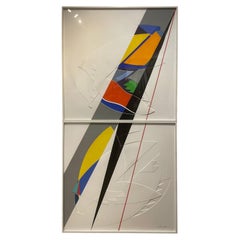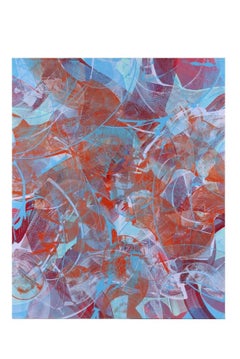Nancy Kay
Recent Sales
1983 Postmodern 2 Piece Triptych Framed Mix Media by Nancy Kay Signed & Dated
Located in San Diego, CA
Spectacular large 2 piece mix media art by Nancy Kay 1983, original wood lacquer frame with
Category
20th Century American Post-Modern Decorative Art
Materials
Acrylic, Wood, Paper
H 40.5 in W 40.5 in D 1.5 in
Large Abstract Expressionist Gestural Oil painting Sheldon Berlyn Red White Blue
Located in Surfside, FL
Exhibition, Rochester, NY
1981 Le Copain Gallery, Buffalo, NY (solo)
1979 Nancy Kay Gallery, San Diego, CA
Category
21st Century and Contemporary Abstract Expressionist Abstract Paintings
Materials
Canvas, Oil
Pink Rose
Located in Sheffield, MA
work. My mother in law was a member and often they spoke of Nancy Reagan, Kay Spreckles, the Wicks, the
Category
1980s Contemporary Still-life Paintings
Materials
Oil
Get Updated with New Arrivals
Save "Nancy Kay", and we’ll notify you when there are new listings in this category.
Nancy Kay For Sale on 1stDibs
You are likely to find exactly the nancy kay you’re looking for on 1stDibs, as there is a broad range for sale. Find contemporary versions now, or shop for contemporary creations for a more modern example of these cherished works. If you’re looking for a nancy kay from a specific time period, our collection is diverse and broad-ranging, and you’ll find at least one that dates back to the 20th Century while another version may have been produced as recently as the 21st Century. If you’re looking to add a nancy kay to create new energy in an otherwise neutral space in your home, you can find a work on 1stDibs that features elements of black and more. Finding an appealing nancy kay — no matter the origin — is easy, but Bruce Rubenstein each produced popular versions that are worth a look. These artworks were handmade with extraordinary care, with artists most often working in mixed media, paint and acrylic paint.
How Much is a Nancy Kay?
The average selling price for a nancy kay we offer is $5,950, while they’re typically $1,250 on the low end and $35,000 for the highest priced.
More Ways To Browse
80s Interior Design
Stanton Hall Sterling
Steel Guitar
Steiff Animals Vintage
Steiff Animals
Sterling Cake Stand
Sterling Pagoda
Sterling Shoe Horn
Sterling Silver Butter Spreaders
Sterling Silver Cake Stand
Sterling Silver Flatware Set 45 Piece Set
Sterling Silver Gorham Chantilly Tea Set
Sterling Silver Letter Rack
Sterling Silver Mirror Plateau
Sterling Silver Overlay Lenox
Sterling Silver Perfume Bottle Mexican
Sterling Silver Pickle Fork
Sterling Silver Quaich

